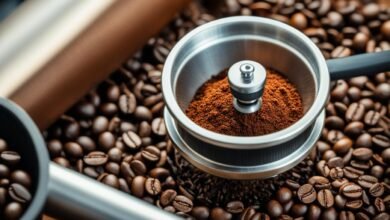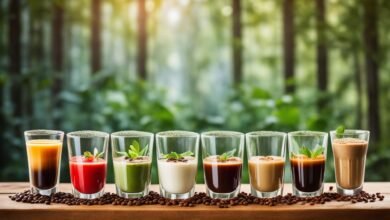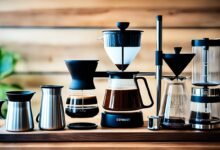How to Select the Best Coffee Beans for Your Taste

As I savor my morning cup of coffee, the rich aroma fills the air, transporting me to lush coffee plantations and bustling cafes around the world. The journey from bean to brew is a fascinating one, and choosing the right coffee beans is the first step to crafting the perfect cup. Whether you’re a seasoned coffee connoisseur or just beginning to explore the vast world of specialty coffee, navigating the endless options can feel overwhelming. But fear not, fellow coffee lover – this comprehensive guide will equip you with the knowledge to find your ideal beans and elevate your daily coffee experience.
Key Takeaways
- Understand the differences between Arabica and Robusta coffee beans to find your preferred flavor profile.
- Explore single-origin coffees and blends to discover unique regional characteristics and balanced flavors.
- Learn how roast levels impact the taste, aroma, and caffeine content of your coffee.
- Prioritize freshness to ensure you’re enjoying your coffee at its peak flavor.
- Consider ethical and sustainable coffee sourcing to support responsible farming practices.
Overview
When it comes to the world of coffee, the journey begins with selecting the right beans. The foundation of a delightful cup lies in understanding the nuances of coffee varietals, roast levels, and freshness. From the smooth and sweet Arabica beans to the bold and earthy Robusta beans, each coffee cultivar offers a unique flavor profile that caters to diverse preferences among specialty coffee enthusiasts.
Variety/Cultivar
The two primary coffee species are Coffea arabica and Coffea robusta. Arabica beans are renowned for their delicate, complex flavors, often exhibiting notes of chocolate, fruit, or berries. In contrast, Robusta beans are typically more gritty, bitter, and earthy in taste. Arabica, generally considered the superior variety, thrives in higher-altitude regions, while Robusta is more resilient and easier to cultivate.
Single Origin Coffee vs Blends
Single-origin coffees showcase the unique characteristics of a specific region or country, allowing you to experience the distinct terroir and seasonal flavors. These specialty coffee offerings are often made from Arabica beans, providing an opportunity to explore the diverse taste profiles of the coffee world. Blends, on the other hand, combine beans from multiple origins, creating a harmonious and well-balanced flavor profile that appeals to a broader range of coffee drinkers.
Roast Level
The roast level of coffee beans significantly impacts the flavor, aroma, and mouthfeel of the final brew. Light roasts retain more of the bean’s original flavors and exhibit a bright acidity, while medium roasts offer a balanced, chocolatey profile. Dark roasts are less acidic and have a rich, smoky taste, though they contain less caffeine than lighter roasts.
Freshness
Freshness is a critical factor in selecting high-quality coffee beans. Roasted coffee begins to lose its flavor and aroma shortly after roasting, so it’s best to consume it within 7 to 21 days of the roast date. Always check the roasting date on the package and choose the most recently fresh roasted coffee for the best coffee experience.
“The true art of coffee lies in the careful selection and preparation of the beans, unlocking the complex flavors that await the discerning palate.”
Tips for Choosing Coffee Beans
Selecting the perfect coffee beans is a journey of personal discovery. Your taste preferences, the growing region, elevation, and processing method all play a crucial role in determining the final flavor profile. By understanding these factors, you can embark on an exciting exploration to find the coffee that truly resonates with your palate.
What’s Your Desired Taste Profile?
Start by considering your coffee taste preferences. Do you gravitate towards bright, acidic notes or richer, more chocolatey flavors? Knowing whether you enjoy your coffee black or with milk can also help guide your bean selection. High-quality Arabica beans offer a wide range of flavor profiles, from floral and fruity to nutty and spicy.
Growing Regions
The growing region of coffee beans significantly influences their taste. Coffees from Africa, such as those from Ethiopia, Rwanda, and Kenya, tend to have bright, floral, and fruit-forward notes. Central American coffees, like those from Costa Rica, Guatemala, and Nicaragua, are clean and well-balanced with moderate acidity and fruity tones. South American coffees, including those from Brazil, Peru, and Colombia, often showcase pronounced chocolate and nut flavors. Southeast Asian coffees, such as those from Indonesia, are known for their earthy, nutty, and spicy characteristics.
Growing Altitude
The elevation at which coffee is grown also impacts the flavor profile. Low-altitude coffee (below 1250 meters) tends to have a heavier body and more refined acidity. Medium-altitude coffee (1250-1500 meters) is often sweeter and more luscious, with a little more acidity. High-altitude coffee (1500-2200 meters) is more complex and aromatic, with pronounced acidity and sweet fruit or wine-like undertones.
Processing Method
The way coffee is processed after harvesting also influences the final taste. Naturally processed coffees are dried with the fruit still intact, resulting in a sweeter, more complex flavor with a larger body and lower acidity. Washed coffees, on the other hand, have a cleaner, brighter, and more fruit-forward profile due to the pulping and fermentation process. Semi-washed or wet-hulled coffees, common in Indonesia, offer a unique sweetness and acidity.

Caffeine Content
When it comes to coffee, the amount of caffeine present is a crucial factor for many drinkers. The caffeine content in coffee can vary significantly based on the type of coffee bean used. Generally, Robusta coffee beans contain about twice as much caffeine as Arabica beans. Robusta beans have approximately 22 milligrams of caffeine per gram, while Arabica beans have around 12 milligrams per gram.
A single coffee bean, regardless of the variety, typically contains around 6 milligrams of caffeine. However, the overall caffeine content in a cup of coffee can also be influenced by the brewing method. For instance, French press coffee has an average of 108 milligrams of caffeine per 8-ounce cup, while drip coffee methods yield around 145 milligrams per 8-ounce cup. Percolator coffee, on the other hand, can have as much as 200 milligrams of caffeine per 8-ounce serving.
For those seeking a lower-caffeine option, Arabica-dominant coffees or blends may be the better choice. While Robusta beans have a higher caffeine content, professional tasters have noted that the high caffeine levels can sometimes result in a bitter flavor profile. Ultimately, the choice between coffee caffeine content, Arabica caffeine, or Robusta caffeine will depend on individual preferences and needs.
Coffee Bean Selection
When selecting the perfect coffee beans, quality should be the top priority. Seek out specialty coffee from reputable roasters who work directly with coffee growers to ensure ethical and sustainable sourcing practices. Look for certifications like Organic, Rainforest Alliance, or Fair Trade to support responsible coffee production.
European grade coffee beans are a great choice, as they have a maximum of 2% defective beans and are typically more expensive than American grade beans, which can contain up to 4% defective beans at a lower cost. The best-quality coffee beans come from suppliers that offer transparency regarding the origin of their beans, ensuring a higher level of quality from the source.
Coffee freshness is crucial, with beans storing well in un-roasted form for up to a year if stored in good conditions. Dark roast coffee beans are mainly used for espresso and are characterized by their shiny black appearance and low acidity, while light and medium roasts offer a broader range of flavor profiles.
| Coffee Origin | Flavor Profile |
|---|---|
| Brazil | Chocolatey, Nutty |
| Kenya | Bold, Tropical |
| Indonesia | Dark, Earthy, Smoky |
| Central America & Colombia | Light, Balanced, Slightly Acidic, Fruity |
When choosing coffee beans, consider the aroma as well, as it can add qualities such as smoky, floral, fruit-like, or earthy notes that enhance the overall tasting experience.
“The best coffee beans come from suppliers that offer transparency regarding the origin of their beans, ensuring a higher level of quality from the source.”
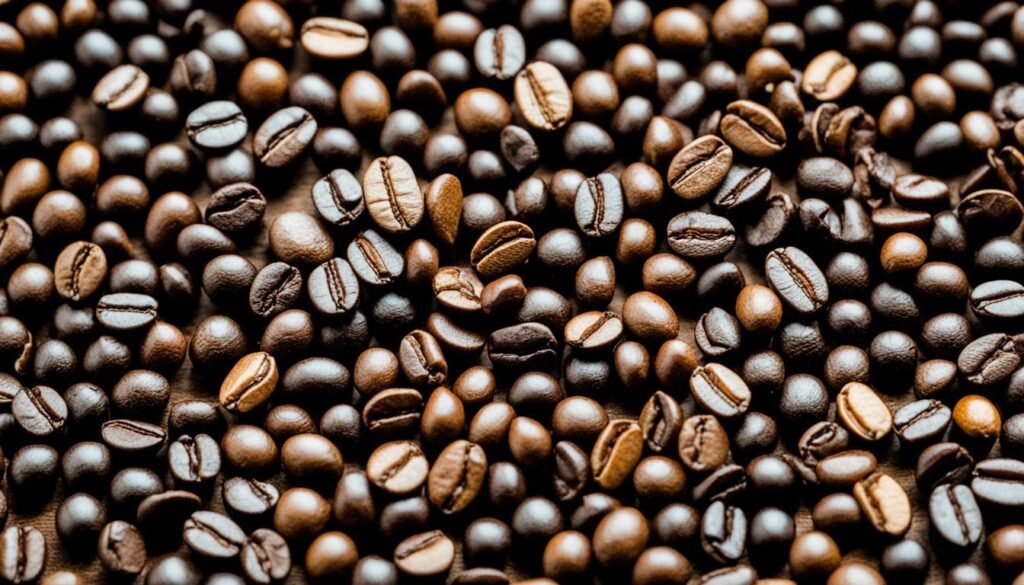
What’s Your Preferred Brewing Method?
The coffee brewing method you choose can significantly impact the final flavor of your cup. From the classic drip machine to the sophisticated pour-over, each technique has its own unique characteristics that can bring out the best in your coffee beans.
For those who prefer a smooth, well-rounded cup, a drip coffee maker is a popular choice. These machines offer the convenience of set-and-forget brewing, making them a go-to for many coffee enthusiasts. On the other hand, pour-over methods, such as the Chemex or V60, allow for more control over the brewing process, often resulting in a cleaner and more nuanced flavor profile.
If you’re a fan of bold, concentrated coffee, the French press or AeroPress might be the way to go. These methods steep the coffee grounds directly in hot water, extracting a full-bodied and robust flavor. For the espresso lovers, a stovetop moka pot can provide a strong, espresso-like experience in the comfort of your own home.
| Brewing Method | Grind Size | Brew Time | Flavor Profile | Equipment |
|---|---|---|---|---|
| Drip | Medium | 5 minutes | Smooth, well-balanced | Automatic drip machine |
| Pour-Over | Medium-Fine | 3-4 minutes | Clean, nuanced | Chemex, V60 |
| French Press | Coarse | 4-5 minutes | Full-bodied, robust | French press |
| AeroPress | Fine-Medium | 1-2 minutes | Sweet, full-bodied | AeroPress |
| Moka Pot | Fine | 5 minutes | Espresso-like, strong | Stovetop moka pot |
When it comes to coffee brewing methods, the choice is ultimately a matter of personal preference. Experiment with different techniques and find the one that best suits your taste buds and brewing routine. Regardless of your preferred method, the key is to select coffee beans that complement your chosen coffee equipment and coffee maker compatibility.

Sustainable Coffee Farming and Fair Trade Initiatives
Responsible coffee sourcing is crucial for ensuring a sustainable future for the industry. When it comes to selecting coffee beans, look for those that are certified organic, Rainforest Alliance, or Fair Trade. These certifications guarantee ethical and eco-friendly farming practices, supporting small-scale coffee growers, protecting the environment, and promoting social and economic justice.
Ethical and Eco-Friendly Coffee
Major coffee companies, like Starbucks, have invested heavily in supporting sustainable coffee communities. Starbucks has committed over $100 million to provide 100 million trees to farmers by 2025, aiming to make coffee the first sustainable agricultural product. The Sustainable Coffee Challenge, a joint initiative with over 100 partners, is working towards industry-wide efforts for sustainability, including an ambitious goal to re-plant 1 billion coffee trees.
Fair trade principles ensure that coffee farmers are paid a fair price for their beans, enabling them to earn a sustainable livelihood, particularly in countries where coffee farming is a major income source. Choosing fair trade coffee beans allows buyers to directly support the economic empowerment of farmers. Direct trade relationships between roasters and farmers also help ensure quality, fair treatment, and higher prices for the beans.
Unethical and Non-Eco Friendly Coffee
In contrast, low-quality, mass-produced coffee often comes at the expense of ethical and sustainable practices. These coffee beans may be sourced from farms with poor working conditions, use harmful pesticides, or contribute to deforestation. When possible, avoid coffee that lacks transparency or certifications regarding its environmental and social impact.
Responsible organizations are working towards carbon-neutral coffee production by implementing sustainable farming techniques, renewable energy sources, and carbon offset initiatives such as reforestation projects. Certifications like Fair Trade and organic labels provide assurance that coffee beans were sourced sustainably and ethically. Local and small-scale roasters often have more direct relationships with farmers, ensuring ethical and sustainable sourcing practices.
Consumer education on coffee brands’ values, sourcing practices, and sustainability commitments can promote ethical and eco-friendly coffee practices. By supporting sustainable and fair trade coffee, we can contribute to a more just and environmentally-friendly coffee industry.
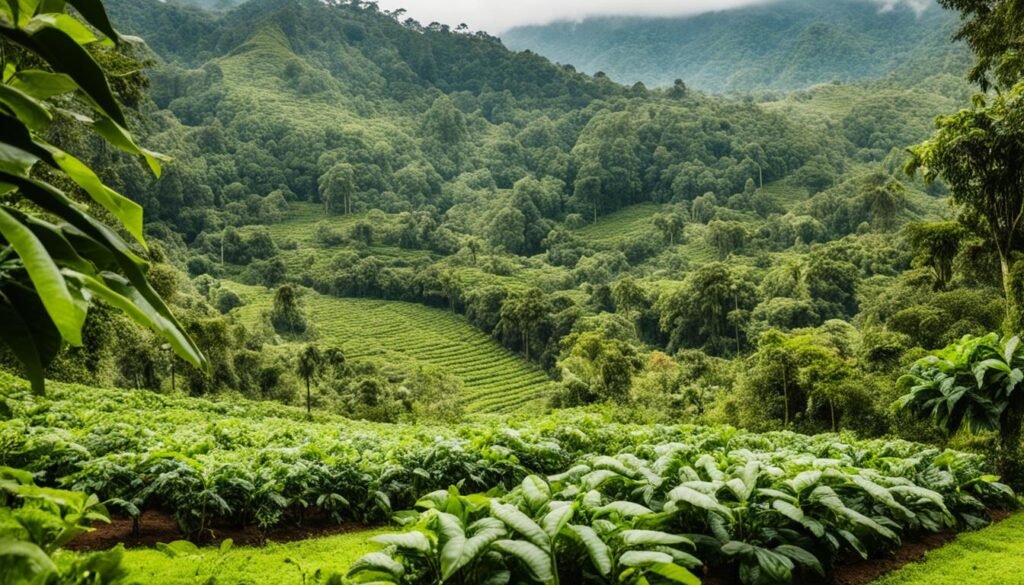
Choosing Coffee
Scantily Labeled Coffee Bean Bags
When shopping for coffee beans, be wary of packages that lack crucial information. Vague labels make it difficult to assess the quality and freshness of the beans. Opt for coffee bags that provide clear and transparent details about the coffee’s provenance and characteristics to ensure you’re making an informed purchase.
Look for coffee bean packaging that includes details such as the roasting date, origin, and processing method. This coffee information transparency allows you to make a more informed decision and find the beans that best suit your taste preferences.
Specialty coffee businesses typically recommend consuming beans no later than 3 weeks from the roasting date. Many coffee companies, however, use Robusta beans in blends to prolong shelf life and enhance crema thickness, which may reduce complexity and vibrancy in the cup.
“Choosing coffee beans with detailed labeling ensures you’re getting the freshest and highest-quality product possible.”
By selecting coffee beans with transparent labeling, you can explore a wider range of origins, processing methods, and roast levels to find the perfect cup that aligns with your personal tastes and brewing preferences.
Freshness Matters
When it comes to coffee, freshness is paramount. Roasted coffee beans begin to lose their flavor and aroma within just a few weeks of the roast date. To ensure the best coffee experience, it’s essential to consume the beans within 7 to 21 days of the roast.
Whole bean coffee can be stored for up to 2-4 weeks, while ground coffee maintains freshness for up to 1-2 weeks. Different roasting profiles, such as light, medium, and dark, require varying degassing times to reach their peak flavor. Brewing with freshly roasted coffee enhances the vibrant flavors and aroma that coffee enthusiasts crave.
Proper storage in airtight, light-blocking containers can extend the shelf life and quality of coffee. Brew Factory’s innovative packaging utilizes one-way valves to preserve coffee freshness even longer. Freshly roasted coffee offers more vibrant flavors and allows the coffee to reach its full potential.
The “freshness window” for roasted coffee is generally considered to be from 2-3 days post-roast to 1-2 months post-roast. Alma Coffee suggests their coffee is best enjoyed between day 7 and 28 post-roast. Coffee beyond its freshness window can exhibit bland, acidic, or sour taste characteristics.
To maintain the freshness of your coffee, be sure to buy freshly roasted beans, switch to whole beans whenever possible, and store your coffee in airtight, light-blocking containers. By prioritizing coffee freshness, you can unlock the full flavor potential of your favorite brew.
| Coffee Freshness Considerations | Optimal Timeframe |
|---|---|
| Whole bean coffee shelf life | 2-4 weeks |
| Ground coffee shelf life | 1-2 weeks |
| Roasted coffee flavor peak | 2-3 days to 1-2 months post-roast |
| Alma Coffee recommended brew window | 7-28 days post-roast |
“Freshly roasted coffee offers more vibrant flavors and allows the coffee to reach its full potential.”
Roasting Level Impacts Flavor
The roasting process plays a crucial role in shaping the flavor profile of coffee beans. From light roasts to dark roasts, each level offers a unique sensory experience that caters to diverse coffee drinkers’ preferences.
Light Roast
Light roast coffee is characterized by its light brown color, sharp acidity, and vibrant flavor profile. These beans preserve the distinct characteristics of their origin, making them well-suited for pour-over or drip brewing methods. The drying and browning phases are shorter, allowing the coffee’s inherent flavors to shine through, often with notes of citrus, floral, and delicate fruit.
Medium Roast
Medium roast coffee offers a well-rounded flavor profile and moderate mouthfeel. These beans are less acidic and more chocolatey and fruity than light roasts, making them a popular choice for many coffee drinkers. Medium roasts are often the go-to for espresso or pour-over brewing, as they strike a balance between the coffee’s origin and roast characteristics.
Dark Roast
Dark roast coffee is distinguished by its deep, rich color and smoky, bittersweet flavor. These beans have a heavier body and lower acidity, which makes them an ideal choice for espresso, cold brew, or black drip coffee with cream and milk. The extended roasting time results in a more pronounced caramelization of the sugars, leading to a pronounced roasty aroma and taste.
Ultimately, the roasting level you choose should be guided by your personal taste preferences and the brewing method you intend to use. Experiment with different roast profiles to discover the flavor profiles that best suit your palate.
Brewing Methods and Coffee Beans
The brewing method you choose can significantly impact the taste of your coffee and the type of beans you should select. Different brewing techniques extract flavors from the beans in unique ways, so it’s essential to find the right balance between your preferred brewing method and the coffee beans you use.
For instance, light roast coffee beans tend to work best with filter-style brewing, such as pour-over or drip coffee. These brewing methods gently extract the delicate flavors and acidity of the beans, resulting in a clean, bright cup of coffee. On the other hand, medium and dark roast beans are often preferred for more robust brewing methods like espresso or French press, which can bring out their deeper, more robust flavors.
When selecting your coffee beans, consider the brewing equipment you have at home. If you own a high-end automatic drip coffee maker, you can enjoy the convenience of a freshly brewed cup with minimal effort. Alternatively, if you prefer a more hands-on approach, a French press or siphon brewer can yield a richer, more full-bodied coffee experience.
Ultimately, the choice of brewing method and coffee beans is a personal one, influenced by your taste preferences and the equipment you have available. Experiment with different combinations to find the perfect match that suits your coffee-drinking style.
| Brewing Method | Recommended Coffee Beans | Flavor Profile |
|---|---|---|
| Drip Coffee | Light to Medium Roast | Balanced, Bright Acidity |
| French Press | Medium to Dark Roast | Full-Bodied, Robust |
| Espresso | Dark Roast | Intense, Concentrated |
| Pour-Over | Light to Medium Roast | Delicate, Complex |
Remember, the key to a great cup of coffee is finding the perfect balance between your brewing method and the coffee beans you choose. With a little experimentation, you’ll discover the combination that truly satisfies your coffee cravings.
Conclusion
Choosing the perfect coffee beans for your taste preferences is a rewarding journey of exploration and discovery. By understanding the key factors that shape coffee flavor, such as variety, origin, roast level, and processing methods, you can confidently select coffee beans that cater to your unique preferences. Whether you gravitate towards the vibrant, fruity notes of African beans or the balanced, clean profiles of Central American varieties, the world of specialty coffee offers a wealth of options to explore.
Remember, freshness is paramount when it comes to coffee quality, so prioritize purchasing from reputable specialty roasters or directly from producers like Café Real, who are committed to sustainable practices and preserving the authentic flavors of their coffee selections. By embracing the nuances of coffee selection, you can embark on a flavorful coffee recommendations journey and develop a deeper appreciation for the coffee buying guide that goes into crafting a truly exceptional cup of coffee.
The pursuit of the perfect coffee is an ongoing exploration, and with the right knowledge and a willingness to experiment, you can discover the coffee beans that truly resonate with your personal taste preferences. Embrace the diversity of coffee and immerse yourself in the rich narratives and sustainable practices that define the specialty coffee industry, one cup at a time.
